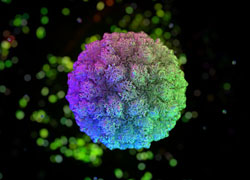03 Oct 2016
Doherty Institute researchers identify new strain of norovirus
Doherty Institute scientists have identified a new recombinant strain of norovirus, the most common cause of viral gastroenteritis, and predict it has potential to become a worldwide epidemic in coming months.
Royal Melbourne Hospital’s Victorian Infectious Diseases Reference Laboratory (VIDRL) based at the Doherty Institute published their work in Eurosurveillance. The Victorian Department of Health published a health advisory based on the research.
Dubbed ‘GII.4 Melbourne 2016’, the new strain was first seen in Victoria in August 2015, and then re-emerged in June 2016, having undergone further genetic changes. Between June and September this strain has taken over as the dominant cause of norovirus outbreaks in Victoria.
VIDRL Director, Dr Mike Catton said that VIDRL’s surveillance data since 2002 indicated that new norovirus strains had caused epidemics between two and seven months after first appearing. Recognising this lead time between appearance of novel strains and epidemics, and hence being able to forecast a possible widespread epidemic has been part of the novelty of the current study.
“Based on years of experience monitoring new norovirus strains, we think that this new strain is genetically different enough to cause an epidemic. Spread of new norovirus strains is often national and international,” he said.
Dr Catton said this strain of gastroenteritis differs from others because no-one in the community is likely to have immunity to it.
“The illness caused by GII.4 Melbourne 2016 is likely to be much the same as caused by other norovirus strains,” he explained. In most people this amounts to self-limited vomiting and diarrhoea rarely lasting more than two days.
“However the elderly, the very young and other members of the community who are immunocompromised are at-risk of more severe disease, and so we have alerted public health authorities and colleagues in the healthcare community”.
“We can’t be certain that an epidemic will occur, but providing an advance warning may help reduce its severity if it does.”
“Prevention relies on high standards of hygiene, particularly effective handwashing, and for two days after symptoms resolve avoiding food preparation, or work in childcare or healthcare facilities.”
Research and analysis for this project was conducted at VIDRL by Leesa Bruggink, Dr Mike Catton and Dr John Marshall. In related work Dr Jason Roberts has used supercomputer technology to perform a 3-dimensional prediction and reconstruction of the new norovirus from its genetic code (pictured).



